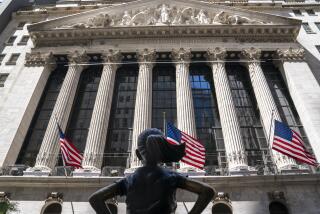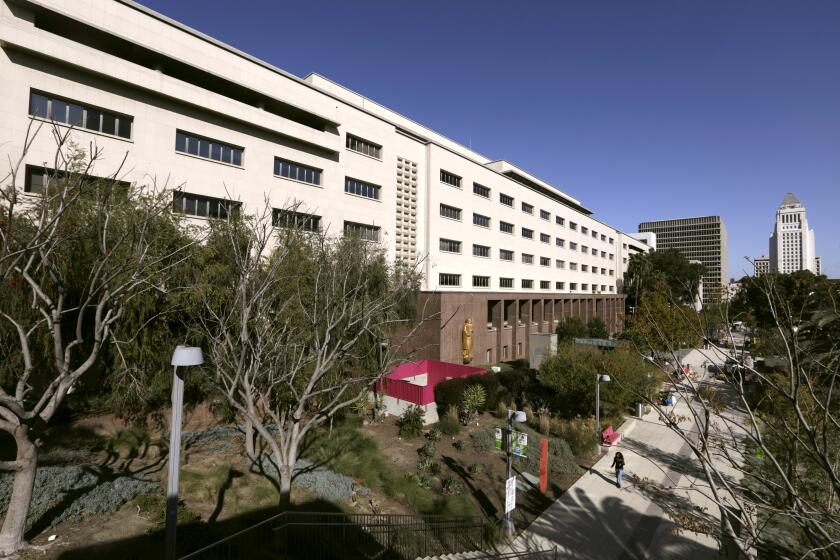Small Stocks Rise as Blue Chips Stumble
- Share via
Small-company stocks set a new high for the fifth straight session, but blue chips stumbled Thursday as a warning from Nike fed fears that company profits won’t justify the market’s lofty levels.
The Dow Jones industrial average fell 27.05 points to 7,330.18 and has now slipped about 53 points after reaching a record-high close Tuesday.
The Nasdaq market also succumbed to some profit taking, particularly among bellwether technology shares, after closing at record highs for three straight sessions.
“When you get up this high, there isn’t much room for disappointment, and you saw that today,” said William M. Lefevre, senior market analyst at Ehrenkrantz King Nussbaum, noting Nike’s discouraging profit forecast. “But I don’t think this is a peak. The market is right now in a pause--a mini-consolidation from a pretty good run.”
The broad market displayed a more positive tone than the blue-chip sector, with advancing issues outnumbering decliners and the Russell 2,000 list of smaller companies closing at a record high for the fifth straight session.
The blue-chip sector struggled despite a strong day in the bond market, where interest rates fell from worrisome levels after an auction of new Treasury securities attracted strong demand.
“The stock market didn’t respond much to the bond market. It was a day when people were worried about earnings,” said A. Marshall Acuff Jr., market strategist at Smith Barney. Acuff also pointed to new reports that surplus inventories may force Seagate Technology to cut back on production of its disk drives.
Bonds had edged higher Thursday morning despite a Labor Department report showing that the number of American workers filing first-time claims for jobless benefits was unchanged last week at 322,000, a level analysts say is consistent with modest job growth.
Economists have been concerned that a strong job market and robust consumer confidence will force companies to raise wages and prices as they compete for workers to meet demand.
The markets have rallied since mid-April amid signs that the vigorous economic pace may be easing enough to keep a lid on inflationary pressures without another boost in interest rates by the Federal Reserve Board.
The inflation-wary Fed moved to slow the economy in late March by raising a key short-term lending rate, prompting a sharp downturn in the markets. Investors had been worried that the central bank might slow consumer borrowing too much, hurting company profits, but Fed officials passed on an opportunity to raise rates again last week.
Advancers outnumbered decliners by more than a 4-3 margin on the New York Stock Exchange, where volume was modest at 460.48 million shares, down from 487.19 million in the previous session.
The Standard & Poor’s 500-stock list fell 3.13 points to 844.08, the NYSE’s composite index fell 0.80 point to 438.86 and the Nasdaq composite index fell 7.14 points to 1,403.04.
The Russell 2,000 rose 0.64 point to 378.43. The American Stock Exchange composite index, which is dominated by smaller companies, rose 2.33 points to 603.12.
The two most active NYSE issues were Nike, down 8 7/8 to 55 1/8, and Seagate, which fell 4 to 40 3/8.
In the technology sector, IBM fell 2 3/8 to 87 3/4 as the Dow’s weakest issue, while in Nasdaq trading, Intel fell 3 23/64 to 163 49/64 and Dell Computer fell 5 1/4 to 110 3/8.
Overseas, Tokyo’s Nikkei stock average fell 0.2% and London’s FTSE-100 fell 0.1%. German financial markets were closed for a holiday.
Soybean prices soared as processors scrambled to secure dwindling stocks, while coffee prices hit the highest levels in 20 years on worries about supplies.
At the Chicago Board of Trade, soybeans for delivery in July closed 20 cents a bushel higher at $8.695 after jumping the allowable 30-cent daily trading limit early.
Triggering the surge was talk that Continental Grain, a leading exporter, had sold warehouse receipts for more than 1 million bushels of soybeans to a processing company in the eastern Corn Belt that was trying to find supplies.
A spokesman for Continental declined to comment, but analysts said the key was a sharp drop of 1,245,000 bushels in warehouse stocks of soybeans to 35,000 total bushels registered for delivery at the CBOT in Chicago on Thursday.
At the Coffee, Sugar and Cocoa Exchange in New York, the sizzling rally in coffee prices carried into a third straight session, with prices shattering the $3-a-pound barrier.
Coffee for July delivery closed up 19.25 cents a pound, or 6% higher, at $314.80 after rising as high as 318 cents, the highest price for coffee on the exchange in two decades.
“We are seeing history happen,” said Christian Wolthers, vice president of Miami-based importer Blaser & Wolthers Specialty Coffee Trading Co. “We’ve not seen a market move like this without frost, drought or any other kind of tragedy. It is a clear situation of short supply for demand.”
Consuming and producing countries’ depleted inventories, hovering near 20-year lows, have been behind coffee futures’ sustained five-month run-up. Since the beginning of the year, the July contract has rallied more than 175%.
The record-high price for coffee on the exchange is 340.70 cents a pound, set April 14, 1977.
The latest fear among traders is that as cold weather sets in during the Brazilian winter next month, coffee trees could be damaged, as they were in June 1994.
More to Read
Inside the business of entertainment
The Wide Shot brings you news, analysis and insights on everything from streaming wars to production — and what it all means for the future.
You may occasionally receive promotional content from the Los Angeles Times.










